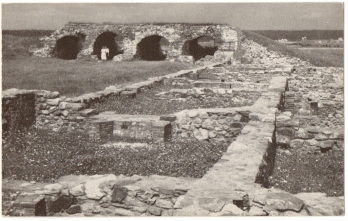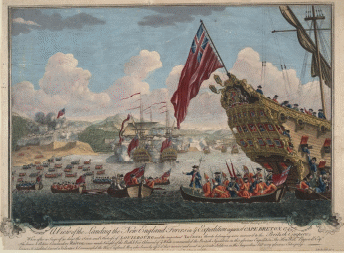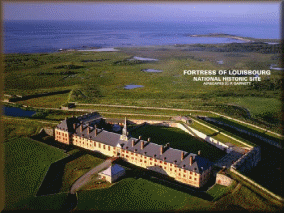Fortress of Louisbourg in Cape Breton is one of the most significant historic sites in North America. Its setting and massive towering walls reflect a bygone era when Nova Scotia was a battleground. The document Fortress of Louisbourg National Historic Site provides basic information by highlighting key events on the war between France and Britain fought in Nova Scotia.
It points out that the Fortress of Louisbourg was created in the year 1713 after the great European war between the French and English crowns ended. The national historic site explores the history of the struggle for an empire by the French and British masters. Today, its location on the Atlantic is a fully protected setting. It is an archeological site with natural landscape. It has a varied and complex profile that offers an alternative tourist destination.

Archives of the social cultural, political and economic history of Louisbourg and the rest of Cape Breton Island are kept in the Beaton Institute. As a source of significant historical records, the institute plays a huge role of providing international, national, regional and local researchers with community-based platforms where inquiries on historic events can be made.
To locate documents and other visual aids that assist in understanding historical writings, Beaton institute provides manuscript guides, how to search and use archives and libraries. It has a very active library for both past and modern archived materials as well as contemporary art that addresses a wide subject matter. Searching and locating the document on the Fortress of Louisbourg in the Beaton Institute requires an individual to go through the following steps:
- Physical visit to the institute and request access from staff members or visit the website.
- Search the archives using the keywords “history of empire” and narrow down the search to unique records. Under Authority records, you will find the document “The Fortress of Louisbourg National Historic Site”
Relevant historical context needed to understand the document
The Fortress of Louisbourg document like any other historical manuscript seeks to create an understanding of the events that led to the establishment of the Canadian national historic site. It uses cases, relevant matters and context discovery to explain historical events that were very crucial in sustaining the activities of the period between 1713 and 1768. One of the cases highlighted by the document is the history of Cape Breton Island.
It was formerly a French settlement. The document indicates that it was established way back in 1629 by the French. Its capital was the Fortress of Louisbourg located near the south point of the Atlantic coast. The document highlights that the historical site was once a popular port where trade and export activities took place.
It further notes that the site was fortified to protect its inhabitants. Notably, these cases provoke a personal consideration since an individual is left sympathetic of the effects of the war and compelled to appreciate the historical site and indeed the positive contribution of the document in promoting learning.
The context of the war is brought out in the document in order to establish key influences that guided the battle between France and Britain. It uses subjects and themes such as the desire to own fishing grounds in the Atlantic coast and the harbor. It explains interesting facts leading to the war and destruction of the French fortress in the 1960s.
It cites that the squadron of the British Royal Navy together with the New England force first besieged the fortress in 1745. The French led by Jean-Baptiste de La Rochefoucauld de Roye sought to defend their territory but were overwhelmed by the British army.
Besides several treaties were signed. Examples include the Treaty of Ulretch in 1713 that saw Nova Scotia awarded to Britain and Louisbourg to the French and the Treaty of Aix-la-Chapelle after the first siege that saw Louisbourg left under the dominance of the French. The events are therefore tailored to capture the series of occurrences that are critical in understanding the historical document.

The account that led to the creation of the Louisbourg historical site is contained in this resource. It was one of the greatest events in the history of British and French empires. It deeply evaluates the main events thereby creating a flow of events, themes and contexts that aid in appreciating historical facts that lead to the creation of empires.
The entire document is therefore designed to capture the attention of people from all ages and professional backgrounds. Insightful use of historical contexts and themes are important in bringing historical knowledge to the current generation. Most importantly, historical contexts depict how contemporary events have been shaped by the past.
Analysis and contributions of the document
One of the main considerations that make the document stand out is its guided historical derivation. By bringing out the series of historical accounts that led to the ruins of Louisbourg, it emphasizes that the quest by empires for dominance and rule over others have been a reality for a long time and the cumulative effects are reflected in the current landscapes and ruins.
As an academic document, it carefully brings out historical accounts in a logical and harmonic manner. These considerations fascinate readers and effectively discuss the underlying issues in an objective manner. At the beginning of the article, a reader is able to obtain a glimpse understanding of the contents from the abstract and introductory sections.
The effectiveness of a historical resource to captivate a reader is largely drawn from its ability to link the past claims with currents happenings. At every stage of the development of accounts in Nova Scotia and the war between the French and British armies, there is ample support of facts from previous researches and theoretical analysis.

Historical sites such as the modern-day Fortress of Louisbourg National Historic Site generally go beyond being wonderful sites to see since they are considered to be part of the learning process to inform visitors, students, learners, researchers and the community at large. The document seeks to enrich the knowledge of its readers on the past events and contributes towards understanding the genesis and development of contemporary events.
Besides, the relationship of past events brought out in the document create a special connection between the past and present and hence, makes the document an important learning tool for the current generation. In other words, this document can be sufficiently used to teach, mold, mentor, guide and inform readers about the events that shaped Nova Scotia.